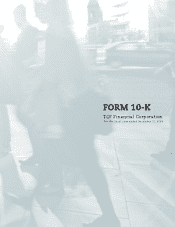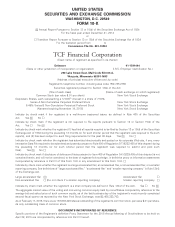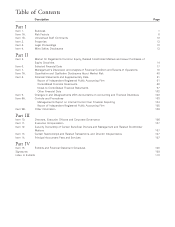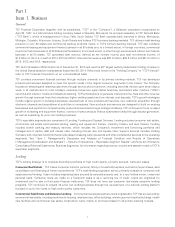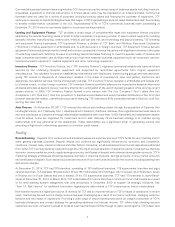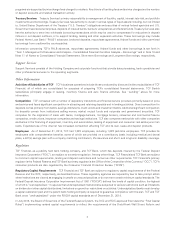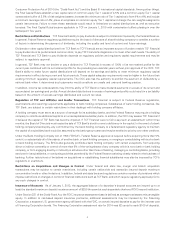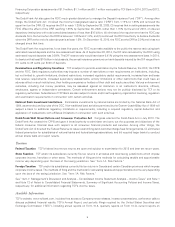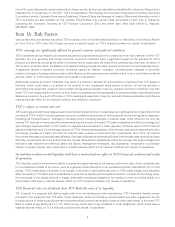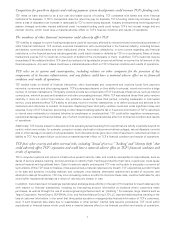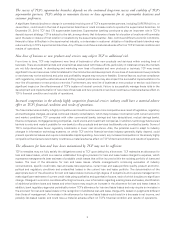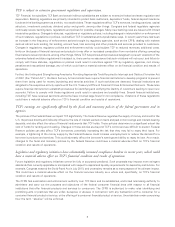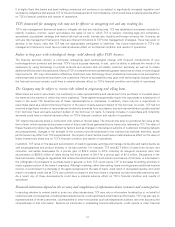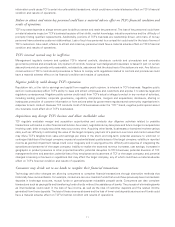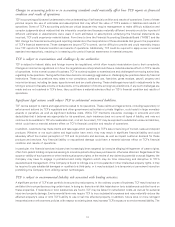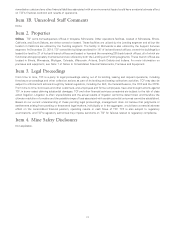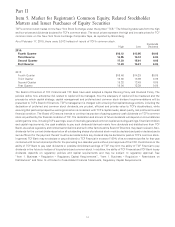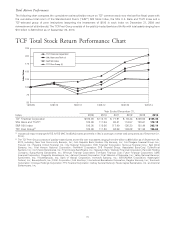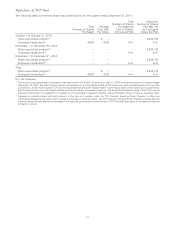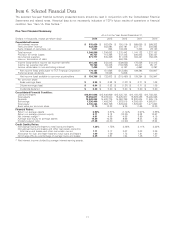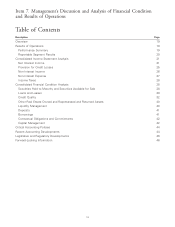TCF Bank 2014 Annual Report Download - page 21
Download and view the complete annual report
Please find page 21 of the 2014 TCF Bank annual report below. You can navigate through the pages in the report by either clicking on the pages listed below, or by using the keyword search tool below to find specific information within the annual report.The success of TCF’s supermarket branches depends on the continued long-term success and viability of TCF’s
supermarket partners, TCF’s ability to maintain licenses or lease agreements for its supermarket locations and
customer preferences.
A significant financial decline or change in ownership involving one of TCF’s supermarket partners, including SUPERVALU Inc. or
Jewel-Osco, could result in the loss of supermarket branches or could increase costs to operate the supermarket branches. At
December 31, 2014, TCF had 178 supermarket branches. Supermarket banking continues to play an important role in TCF’s
deposit account strategy. TCF is subject to the risk, among others, that its license or lease for a location or locations will terminate
upon the sale or closure of that location or locations by the supermarket partner. Also, continued difficult economic conditions,
financial or labor difficulties in the supermarket industry, or a decrease in customer utilization of traditional bank branches may
reduce activity in TCF’s supermarket branches. Any of these could have a material adverse effect on TCF’s financial condition and
results of operations.
New lines of business or new products and services may subject TCF to additional risk.
From time to time, TCF may implement new lines of business or offer new products and services within existing lines of
business. There are substantial risks and uncertainties associated with these efforts, particularly in instances where the markets
are not fully developed. In developing and marketing new lines of business and new products or services, TCF may invest
significant time and resources. Initial timetables for the introduction and development of new lines of business and new products
or services may not be achieved and price and profitability targets may not prove feasible. External factors, such as compliance
with regulations, competitive alternatives and shifting market preferences may also impact the successful implementation of a
new line of business or a new product or service. Furthermore, any new line of business or new product or service could have a
significant impact on the effectiveness of TCF’s system of internal controls. Failure to successfully manage these risks in the
development and implementation of new lines of business and new products or services could have a material adverse effect on
TCF’s financial condition and results of operations.
Increased competition in the already highly competitive financial services industry could have a material adverse
effect on TCF’s financial condition and results of operations.
The financial services industry is highly competitive and could become even more competitive as a result of legislative, regulatory
and technological changes, as well as continued industry consolidation, which may increase in connection with current economic
and market conditions. TCF competes with other commercial banks, savings and loan associations, mutual savings banks,
finance companies, mortgage banking companies, credit unions and investment companies. In addition, technology has lowered
barriers to entry and made it possible for non-banks to offer products and services traditionally only provided by banks. Some of
TCF’s competitors have fewer regulatory constraints or lower cost structures. Also, the potential need to adapt to industry
changes in information technology systems, on which TCF and the financial services industry generally highly depend, could
present operational issues and require considerable capital spending. As a result, any increased competition in the already highly
competitive financial services industry could have a material adverse effect on TCF’s financial condition and results of operations.
The allowance for loan and lease losses maintained by TCF may not be sufficient.
TCF’s remedies may not fully satisfy the obligations owed to TCF upon default by a borrower. TCF maintains an allowance for
loan and lease losses, which is a reserve established through a provision for loan and lease losses charged to expense, which
represents management’s best estimate of probable credit losses that will be incurred within the existing portfolio of loans and
leases. The level of the allowance for loan and lease losses reflects management’s continuing evaluation of industry
concentrations, specific credit risks, loan and lease loss experience, current loan and lease portfolio quality, present economic,
political and regulatory conditions and unidentified losses in the current loan and lease portfolio. The determination of the
appropriate level of the allowance for loan and lease losses involves a high degree of subjectivity and requires management to
make significant estimates of current credit risks using qualitative and quantitative factors, each of which is subject to significant
change. Changes in economic conditions affecting borrowers, new information regarding existing loans and leases, identification
of additional problem loans and leases and other factors may require an increase in the allowance for loan and lease losses. In
addition, bank regulatory agencies periodically review TCF’s allowance for loan and lease losses and may require an increase in
the provision for loan and lease losses or the recognition of additional loan and lease charge-offs, based on judgments different
than those of management. An increase in the allowance for loan and lease losses would result in a decrease in net income, and
possibly risk-based capital, and could have a material adverse effect on TCF’s financial condition and results of operations.
8


